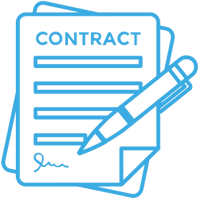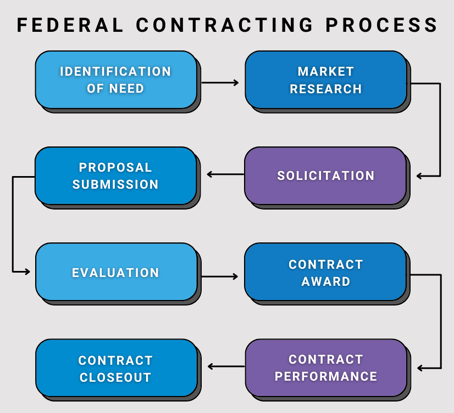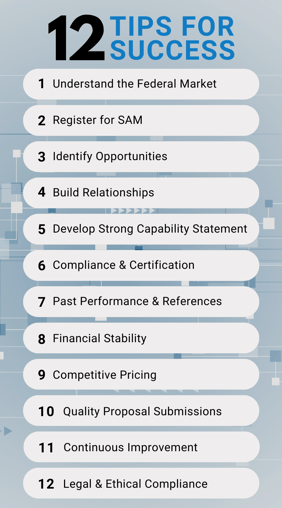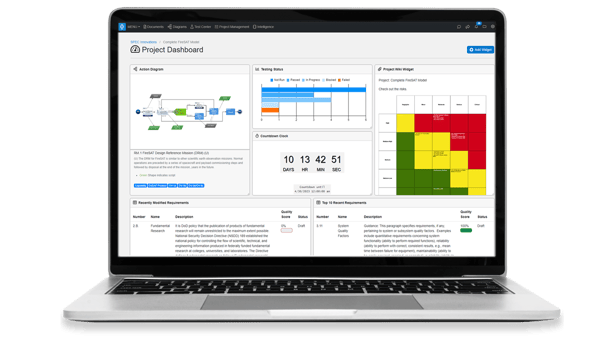
The Ultimate Guide to Winning Federal Contracts

-
The Ultimate Guide to Winning Federal Contracts
- Introduction
- What are Federal Contracts?
- 12 Tips for Success to Win a Federal Contract
- Building Your Team
- What is Innoslate?
- Facilitate Clear Communication Channels
- Define Roles and Responsibilities
- Use Agile Task Management
- Identify and Manage Risks
- Track Compliance
- Improve With Lessons Learned
- Make Data-Driven Decisions
Introduction
In the world of federal contracts, assembling a strong team is the key to success. This guide explores federal contracts, beginning with what they are and how you can get started using our tips for success. We will then look into how to build and empower strong teams, ensuring your federal contracts are not just fulfilled, but that you go above and beyond.
We will also investigate Innoslate, and how it can meet the needs that come with bidding on and winning contracts. This will explore fulfilling proposal and contract processes and needs such as communication, roles/responsibilities, agile task management, risk management, compliance, lessons learned, and data-driven decisions.
What Are Federal Contracts?
Federal contracts are business agreements or arrangements between private companies or organizations and the federal government. In the United States, federal contracts are agreements entered into by the U.S. federal government and private entities for the provision of goods, services, or construction projects.
These contracts are a critical part of the government's ability to fulfill its many functions and responsibilities. Federal agencies use contracts to get necessary resources, expertise, and support to carry out their missions. The types of goods and services that come from these contracts are diverse and can include anything from information technology services and defense equipment to construction projects and research studies.
The federal contracting process typically involves these key steps:
- Identification of Need: Federal agencies identify their need for goods/services to fulfill their missions or specific projects.
- Market Research: Agencies conduct market research to identify potential sources and solutions available in the private sector.
- Solicitation: Agencies issue solicitations, which can take the form of a Request for Proposal (RFP), Request for Quotation (RFQ), or Request for Information (RFI), outlining their requirements and inviting businesses to submit proposals.
- Proposal Submission: Interested businesses submit proposals that detail how they can meet the government's requirements, including pricing, capabilities, and other relevant information.
- Evaluation: Government officials evaluate the proposals based on their criteria, which may include technical capabilities, past performance, and cost.
- Contract Award: The government awards the contract to the selected vendor(s) based on the evaluation results.
- Contract Performance: The selected vendor(s) perform the work or provide the goods and services as specified in the contract.
- Contract Closeout: Once the work is completed, the contract is closed, and final evaluations and payments are made.

Federal contracts are governed by various laws, regulations, and guidelines to ensure transparency, fair competition, and accountability. Companies interested in pursuing federal contracts must comply with these regulations and meet certain eligibility criteria.
The process is often competitive, and successful contractors are those who can demonstrate their ability to meet the government's needs effectively and efficiently.
The process from the identification of need to contract award frequently takes up to 18 months and sometimes even more. A typical contract will be for one year and four option years. Since this is such a long process, customers want to know that the capabilities they are looking for exist in the contracting community before the RFP release.
12 Tips for Success to Win a Federal Contract
Beginning the journey to winning federal contracts can seem intimidating. Rome wasn’t built in a day, and neither is your pipeline to win. There are tasks and plans you need to put in place to build yourself up for success. Here are 12 tips that will improve your chances of winning that contract.

1: Understand the Federal Market
Research the federal market thoroughly. Identify agencies relevant to your business, understand their missions, and stay updated on their procurement needs. Recognize the specific challenges and requirements within the federal sector that align with your offerings.
2: Register in the System for Award Management (SAM)
SAM is a mandatory registration for all federal contractors. Ensure your business details, including financial and contact information, are accurate. Keep your registration up to date to remain eligible for federal contracts.
3: Identify Opportunities
Regularly check government procurement websites like SAM.gov, GovWin IQ, GovTribe, and more for new opportunities. Utilize advanced search features to filter contracts based on your industry, location, and other relevant criteria. Set up alerts to receive notifications about upcoming opportunities.
4: Build Relationships
Attend industry events, conferences, and networking sessions to connect with federal procurement officials, contracting officers, and other businesses. Developing relationships can provide insights into upcoming opportunities and increase your visibility in the federal market. This is extremely important for building a winning team, which we will talk further about.
5: Develop a Strong Capability Statement
Craft a concise capability statement that highlights your company's key competencies, relevant experience, and differentiators. This document is often the first impression federal agencies have of your business, so make it compelling and tailored to the government's needs.
6: Compliance and Certification
Ensure your business complies with relevant regulations and standards. Depending on your industry, obtaining certifications such as ISO or CMMI can demonstrate your commitment to quality and compliance.
7: Past Performance and References
Highlight successful past performances in your proposals. Provide references and testimonials that showcase your ability to deliver quality services or products on time and within budget. Government agencies often require that the team has past experience performing niche tasks so that they feel confident the team they choose can fulfill their needs.
8: Financial Stability
Maintain transparent and robust financial records. Agencies may assess your financial stability to ensure you can fulfill contract requirements. Be prepared to provide audited financial statements or other financial documentation as needed.
9: Competitive Pricing
Develop a pricing strategy that is competitive yet realistic. Understand the government's budget constraints and tailor your pricing accordingly. Clearly outline your pricing structure and justify costs in your proposals.
10: Quality Proposal Submissions
Carefully review and respond to RFPs. Follow all instructions and address each requirement. Clearly articulate how your solution meets the government's needs, and provide evidence to support your claims. Ensure your proposal is well-written, free of errors, and complies with formatting guidelines.
11: Continuous Improvement
Learn from both successful and unsuccessful proposals. Seek feedback when possible and use it to refine your approach. Stay informed about changes in regulations, policies, and industry trends that may impact federal contracting.
12: Legal and Ethical Compliance
Adhere to all legal and ethical standards. Maintain a high level of integrity in your business operations. Any ethical or legal issues can have severe consequences, including disqualification from federal contracting opportunities.
Remember, the federal contracting process can be complex and competitive. Engaging with a professional consultant or attending workshops on government contracting may also provide valuable insights and assistance in navigating the procurement landscape.
Building Your Team
Building a team for federal contracts involves careful consideration of the specific requirements, expertise, and skills needed to successfully bid on and execute government contracts. Here are 10 tasks and tips to consider to build an effective team for federal contracts:
1: Understand Contract Requirements
Begin by thoroughly understanding the specific requirements of the federal contracts you aim to pursue. This understanding includes technical skills, industry experience, certifications, and any other qualifications outlined in the solicitations.
Are you able to fulfill most of these requirements, but don’t have the capabilities for it all? You can partner with another company and bring them on as the subcontractor while you serve as prime contractor. There is also a chance you could join an existing team as one of their subcontractors if you can fulfill a smaller portion of the contract for the team.
2: Identify Key Roles and Responsibilities
Based on the contract requirements, identify the key roles and responsibilities essential for successful contract execution. Common roles include proposal manager or proposal coordinator, bid manager, proposal writer, content manager, capture manager, and graphic designer.
Similar to job applications, the RFP will specify the necessary experience and projected scope of work for each contract role. When it comes to your proposal team, it depends on your resources for how you go about building your team. This flexibility means that one person could serve as the proposal writer and graphic designer.
3: Assemble a Cross-Functional Team
Build a cross-functional team that combines diverse skills and expertise relevant to the contract. This team may include individuals with technical expertise, industry knowledge, legal and compliance acumen, and experience in government contracting.
Between the proposal team and the required personnel that the government needs to perform the actual work, the contract process requires a great deal of people. This need is another good reason to consider building a team made up of experts inside and outside your organization.
4: Proposal and Contracting Experience
Have team members skilled in proposal development. Effective proposal writing is crucial for winning federal contracts. This team includes individuals who can clearly articulate your company's strengths, address the government's requirements, and present a compelling case for why your team is the best fit. Project and systems engineers often have the skills needed to manage the proposal development.
If possible, include team members with prior experience in government contracting. Familiarity with the procurement process, regulations, and the unique aspects of working with government agencies can be a significant advantage.
It’s very beneficial to have individuals with expertise in quality control and assurance. This expertise is crucial for delivering products or services that meet or exceed government standards and expectations.
A great tip to get into federal contracts is to form a relationship with another organization familiar with this and see if you could serve as a subcontractor on a contract with them. This way you can learn the ropes while playing a part on the team. It’s always a good idea to learn how to walk before you start running.
5: Legal and Compliance Expertise
Ensure that your team includes legal and compliance experts who can learn and understand the regulatory landscape of federal contracting. This capability is important for navigating the complexities of government regulations and avoiding legal pitfalls.
6: Project Management Skills
Assign a project manager with strong organizational and project management skills. Government contracts often have strict timelines and deliverable requirements, and a capable project manager can ensure successful project execution.
7: Certifications and Qualifications
Identify any specific certifications or qualifications required for the contract. Ensure that your team members possess these credentials, as they can enhance your competitiveness and compliance with government requirements.
8: Continuous Training
Invest in continuous training for your team to stay updated on changes in government regulations, industry best practices, and other relevant areas. This ongoing education will help your team remain competitive and compliant.
9: Team Collaboration
Build a team that works well together. Between the proposal process and, if you win, the contract process, you could be working together for years. Set yourself up for success by choosing carefully so you create a fostering environment where you can address challenges, share insights, and ensure everyone is aligned with the project goals.
10: Diversity and Inclusion
Consider diversity and inclusion when building your team. A diverse team brings different perspectives, experiences, and ideas, which can enhance creativity and problem-solving capabilities.
In addition to many meaningful perspectives, the government often sets aside contracts for minority groups to have a chance. The U.S. Government has established contract assistance programs for experienced small business owners who are socially and economically disadvantaged. This gives women-owned businesses, veteran-owned businesses, native-owned businesses, and more the opportunity to win over megacorporations that could easily scoop up smaller contracts.
Remember that building a team for federal contracts is not a one-size-fits-all process. Tailor your team composition to the specific requirements of each contract you pursue, and adapt your team structure as needed based on the growing needs of your federal contracting journey.
What Is Innoslate?
Innoslate is a data-driven tool that simplifies team collaboration across all stages of the life cycle, while also offering integrations to help you create a reliable and trusted source of information. The #1 cloud-native Model-Based Systems Engineering (MBSE) tool offers requirements, testing, modeling, project management, simulation, and issue tracking capabilities, just to name a few.
Innoslate is customizable, while also adhering to industry standards. This means it is the perfect platform for your entire contract process, from the very beginning of your proposal to the very end of your contract work.
Facilitate Clear Communication Channels
Communication is the cornerstone of any successful team. With Innoslate's collaborative features, teams can share information seamlessly, reducing the risk of miscommunication and ensuring everyone is on the same page. In Innoslate this begins with the Dashboards.
The Project Dashboard can be configured by the project owner to communicate key pieces of information within the database. Individual users can also use it to help them organize their information.
Real-Time Collaboration
Innoslate provides a platform for real-time collaboration, allowing team members to work on documents, models, and plans simultaneously. This ensures that everyone is on the same page and can contribute to the project in real-time.
Commenting
Team members and reviewers can provide comments on various elements within the project, such as diagrams, documents, or requirements. These comments appear on the project dashboard in the Comments Feed Widget. This feature facilitates clear communication and feedback on specific aspects of the project.
Notifications
Innoslate includes a notification system that alerts team members about updates, comments, or changes made to the project. This ensures that everyone stays informed and can respond promptly to any developments.
Integrated Chat
Innoslate offers messaging capabilities, allowing team members to communicate directly within the platform without having to switch to external messaging tools.
File Sharing
Innoslate supports file sharing through projects, allowing team members to upload and share relevant documents, images, or other files directly within the platform. This contributes to a centralized and organized communication environment.
Activity Feed
Users can review activity in the activity feed, tracking changes, updates, and contributions made by team members. This feature provides transparency and accountability, supporting effective communication within the team.
Define Roles and Responsibilities
Innoslate provides a platform for clearly defining roles and responsibilities within your team. This clarity helps prevent confusion, streamlines workflows, and ensures that each team member knows their specific contributions to the federal contract.
User Roles and Permissions
Innoslate allows organization administrators to define user roles and set permissions for each role. Common proposal/contract roles might include Administrators, Project Managers, Configuration Managers, Engineers, and Reviewers. By assigning specific roles to team members, you can control their access to different features and functionalities within the platform.
Access Control
In addition to the roles discussed above, project owners or organization administrators can determine who has access to specific documents, models, or project components. Critical information (e.g., cost, intellectual property) that you want to limit to certain people can be placed in a separate project to which only a few people have access.
Using cross-project relationships, that information can then be shared with a master project that everyone can access. Users of the master project who do not have access to the other project receive redaction bars. This capability helps in defining responsibilities by restricting or providing access based on role requirements.
Workflow/Task Management
Innoslate offers workflow/task management features that enable users to create, assign, and track tasks. Innoslate’s workflow controls allow an entity’s status to be transitioned through a lifecycle. Workflow can control permissions of the transition, locking, and generating custom notifications.
Innoslate’s Task class entity provides an Assignee attribute. That attribute can also be added to any class. This contributes to defining responsibilities by outlining the specific actions or deliverables expected from each team member.
Configuration Management
Innoslate’s Configuration Management tools contribute to maintaining accuracy and reducing risk. Baselining requirements documents create a read-only snapshot of the document that is preserved until the document is deleted. Innoslate contains a history log for every object, where users can revert to previous versions if needed.
Create test cycles of test suites to organize, manage, and visualize test cases and their results within a project. Branching and Forking abilities allow you to branch and fork projects as well as merge changes between linked projects.
Use Agile Task Management
Agile Systems Engineering is an approach that combines the principles of Agile methodologies with the discipline of Systems Engineering. Systems Engineering is a holistic and interdisciplinary approach to designing, implementing, and managing complex systems. When integrated with Agile principles, Agile Systems Engineering seeks to enhance flexibility, collaboration, and responsiveness in the development of complex systems.
Federal contracts often require adaptability. Agile task management refers to the application of Agile principles and methodologies to the planning, tracking, and execution of tasks within a project. Agile is an iterative and incremental approach to software development, and its principles have been adapted and applied to various project management domains, including task management.
Innoslate embodies Agile Systems Engineering into a tool through its agile task management features. These features enable teams to quickly pivot when needed, ensuring that project timelines are met and potential challenges are addressed proactively.
Requirements
Innoslate uses agile principles in the development of requirements, which are traced through documents and compilation views. The support for requirements development is evident through the use of quality checkers, traceability matrices, and risk analysis tools within Innoslate.
Learn more about managing requirements through Agile at our webinar.
Innoslate’s requirements management tool reduces risk with clear communication through previously mentioned capabilities such as our chat, comments, task management/workflow, and notifications through email and inside Innoslate. Change requests add an extra layer of protection from risk by allowing owners to approve or deny edits to requirements, and view in the Change Request Widget.
Produce and maintain quality requirements with our AI-Powered Quality Checker that provides a score for each requirement, with suggestions for improvement. Keep requirements organized by auto-numbering entities and all related child entities to follow a hierarchical order. Using Round-Trip with Excel, you can edit the data in the Excel sheet, and import your changes back to Innoslate, which will update the original items in the database.
Cross-Project Relationships allow for entities in one project to be related to entities in other projects, ensuring accuracy and completion. The Find and Replace feature allows users to search for specific text strings within a document and replace them with desired content.
Software Engineering Integration
The integration between Innoslate and GitHub streamlines the monitoring of software development processes. The round-trip feature, ensuring effortless status updates between GitHub and Innoslate, underscores the significance of ongoing collaboration between systems engineers and software developers.
Innoslate's robust testing suite integrates with Selenium, the automated testing framework. Innoslate also has MATLAB and Systems Tool Kit (STK) APIs for co-simulation with our discrete event simulator. General Integration capabilities are provided by our JAVA SDK.
Program Management
Innoslate offers a range of program management tools that come from agile methodologies, like the Project Management Dashboard, Kanban board, Gantt chart, Timeline diagram, Calendar, and Countdown Clock. These tools are designed to create a holistic platform for project management, promoting visibility and enhancing collaboration within the team.
Identify and Manage Risks
Federal contracts come with inherent risks, both in proposal development and the program itself. Some potential risks in the lifecycle include:
- Compliance Risks: Federal contracts are subject to a myriad of regulations and compliance requirements. Failure to comply with these regulations can result in legal consequences, financial penalties, and even contract termination.
- Bid and Proposal Risks: The process of bidding for federal contracts is competitive, and preparing proposals can be resource-intensive. There is a risk of investing time and money in a proposal without winning the contract. Developing a winning proposal requires a thorough understanding of the requirements and a strategic approach.
- Contract Performance Risks: Meeting the performance requirements outlined in the contract can be challenging. Delays, cost overruns, or failure to deliver according to specifications can lead to contract disputes, financial penalties, or even contract termination.
- Financial Risks: Financial stability is crucial for successfully executing federal contracts. Projects may require significant upfront investments, and delays in payment or unexpected costs can strain a company's financial resources.
- Political and Budget Risks: Federal contracts can be influenced by political changes and budget uncertainties. Changes in government priorities, funding availability, or policy shifts may impact the continuation or scope of contracts.
- Security and Cybersecurity Risks: Federal contracts often involve sensitive information and data. Companies must comply with security and cybersecurity requirements to protect classified or sensitive information. Failure to do so can result in security breaches, reputational damage, and legal consequences.
- Subcontractor Risks: Many federal contracts involve subcontractors. Reliance on subcontractors introduces additional risks related to their performance, compliance, and financial stability. Poor performance by a subcontractor can ultimately affect the prime contractor's ability to meet contract requirements.
- Change in Requirements Risks: Government needs and priorities may change during the course of a contract. Companies must be adaptable and able to respond to changes in requirements, which can impact project timelines and costs.
- Legal Risks: Engaging in federal contracts exposes companies to potential legal challenges. Contract disputes, bid protests, and allegations of non-compliance can result in legal proceedings and damage a company's reputation.
- Documentation and Record-Keeping Risks: Federal contracts often require meticulous documentation and record-keeping. Inadequate documentation can lead to audit findings, disputes, or challenges during contract performance assessments.
For a Bid and Proposal Risk example, you may have to produce 40 pages of technical approach with only a couple people to write it. You may not be able to complete the writing before the RFP is due. This risk can be mitigated by planning and adding another writer earlier in the proposal process.
Innoslate's risk management tools can help save your team from many of these risks. These tools empower teams to identify potential pitfalls, develop mitigation strategies, and ensure that the project stays on course.
Risk Identification
Innoslate provides tools for identifying and documenting potential risks within a project. This involves the systematic process of recognizing potential issues or uncertainties that may impact project objectives. Innoslate’s Risk Matrix, Risk Burn-Down Chart, and Risk Register all capture and display identified risks.
Risk Analysis
The platform often includes features for analyzing identified risks. This can involve assessing the probability and impact of each risk, allowing project teams to prioritize and focus on the most critical aspects that require attention. You can also look at the schedule and cost risks of your technical processes and plans by using the Monte Carlo simulation capability.
Risk Mitigation Planning
Innoslate supports the development of risk mitigation strategies through Project Management Plan Documents, Integrated Logistics Support Plan Documents, Independent Verification & Validation Plan Documents, and Concept of Operations Documents. Teams can collaboratively document and plan for actions to reduce or eliminate potential risks, ensuring that there is a proactive approach to addressing challenges before they escalate.
Risk Traceability
The tool typically enables traceability of risks throughout the project lifecycle. This means that users can link risks to specific requirements, tasks, or other project components, providing a comprehensive view of how risks may impact different aspects of the project.
Risk Monitoring and Reporting
Innoslate typically includes features for monitoring risks over time. Teams can track the status of identified risks, implement mitigation strategies, and generate reports to communicate the current state of risk management to stakeholders. The Risk Burndown Chart can be used for tracking as well.
Track Compliance
Compliance is paramount in federal contracts. The first thing the customer checks for is compliance, frequently requiring a compliance matrix. Compliance is crucial in federal contracts for several reasons, reflecting the need for adherence to laws, regulations, and contractual requirements.
Here are some key reasons why compliance is important in federal contracts:
- Legal Obligations: Federal contracts involve legal obligations that must be met by both the government and the contractor. Compliance ensures that both parties fulfill their legal responsibilities, preventing legal disputes, fines, or legal actions.
- Regulatory Requirements: The federal government operates within a complex regulatory environment. Compliance with various regulations, such as the Federal Acquisition Regulation (FAR) and agency-specific regulations, is essential to ensure that contractors meet the government's standards and expectations.
- Risk Mitigation: Compliance helps mitigate risks associated with federal contracts. Non-compliance can lead to contract terminations, financial penalties, suspension or debarment from future contracts, and damage to the contractor's reputation. By adhering to compliance requirements, contractors reduce the likelihood of facing these adverse consequences.
- Contractual Obligations: Federal contracts outline specific terms, conditions, and performance requirements. Compliance ensures that contractors fulfill these contractual obligations, including delivering goods or services on time, meeting quality standards, and achieving performance milestones.
- Financial Management: Compliance with federal financial regulations and reporting requirements is critical. Contractors must adhere to accounting and auditing standards, submit accurate financial reports, and maintain proper documentation. This ensures transparency and accountability in financial management.
- Ethical Standards: Compliance with ethical standards is fundamental in federal contracting. Contractors are expected to uphold high ethical standards in their business practices, including preventing conflicts of interest, avoiding bribery or corruption, and promoting fair competition.
- Data Security and Privacy: Federal contracts often involve handling sensitive information. Compliance with data security and privacy regulations, such as the Privacy Act and cybersecurity requirements, is essential to protect government and personal data from unauthorized access, disclosure, or misuse.
- Quality Assurance: Compliance with quality standards is necessary to ensure that products or services meet the specified requirements. Government agencies rely on contractors to deliver high-quality results, and compliance contributes to overall project success and stakeholder satisfaction.
- Social Responsibility: Some federal contracts may have requirements related to social responsibility, environmental sustainability, or other societal considerations. Compliance with these requirements demonstrates a commitment to responsible and sustainable business practices.
- Maintaining Eligibility for Future Contracts: Non-compliance can result in the suspension or debarment of a contractor, making them ineligible for future federal contracts. Maintaining compliance is vital for businesses seeking to establish and sustain a positive relationship with government agencies.
Innoslate's tracking capabilities allow teams to monitor and demonstrate compliance throughout the project, reducing the risk of setbacks and ensuring a smoother contracting process.
Standard Operating Procedures (SOPs)
Standard Operating Procedures (SOP) are documented guidelines or instructions that organizations create to standardize and streamline routine processes and tasks. SOPs are designed to ensure consistency, efficiency, and compliance with regulations or internal policies within an organization.
Key features of SOPs include:
- Consistency: SOPs maintain stability in the execution of tasks and processes, reducing the likelihood of errors or variations in performance.
- Compliance: SOPs often include guidelines to ensure that activities align with industry regulations, legal requirements, or internal policies.
- Training: SOPs serve as valuable training tools for new employees, providing them with clear instructions on how to perform specific tasks or processes.
- Efficiency: By outlining step-by-step procedures, SOPs help streamline operations, saving time and resources while enhancing overall efficiency.
- Reference: SOPs serve as a reference point for employees when they encounter uncertainties or need guidance on how to handle specific situations.
- Quality Assurance: SOPs contribute to maintaining a high level of quality in products or services by specifying standardized procedures that meet certain quality standards.
- Continuous Improvement: Organizations can use SOPs as a basis for evaluating and improving processes over time, ensuring that they stay up-to-date and efficient.
SOPs are commonly found in various industries such as engineering, healthcare, manufacturing, finance, and more, where standardized procedures are critical for operational success and regulatory compliance.
The SOP Document in Innoslate provides a structured approach to document procedures and operations within an organization. SOPs can help ensure compliance with industry standards and regulations, providing a clear record of adherence to prescribed processes.
Define Compliance Requirements
Innoslate allows users to define and document compliance requirements relevant to their specific industry or standards. This involves specifying the criteria, regulations, or guidelines that need to be followed for a project to remain compliant.
Link Requirements to Entities
Users can link compliance requirements to various project elements, such as documents, models, or specific tasks. This linkage creates a traceability matrix, showing how each project component aligns with the defined compliance criteria.
Traceability Matrix
The Traceability Matrix helps users visualize how well the project aligns with the specified compliance standards. Innoslate provides traceability views that display the relationships between different project elements and compliance requirements.
Reports and Documentation
Innoslate offers reporting tools that allow users to generate compliance reports. Use the Document and Compilation Views to create reports and documents. You can also export any results to MS Office, including Word, Excel, PowerPoint, and Project. These reports can be shared with stakeholders, auditors, or regulatory bodies to demonstrate the project's adherence to compliance standards.
Improve With Lessons Learned
In federal contracts, "lessons learned" refers to insights and experiences gained throughout the lifecycle of a contract. These lessons are typically documented and analyzed to improve future contract management and execution. Here are some key aspects related to lessons learned in federal contracts:
- Documentation: Contracting officers and project teams are encouraged to document their experiences, both positive and negative, during the execution of a federal contract. This documentation can include challenges faced, successful strategies employed, and any unexpected issues that arose.
- Analysis: After the completion of a federal contract, a thorough analysis of the project's successes and failures is conducted. This analysis involves reviewing the contract's performance, identifying areas of improvement, and assessing how well the objectives were met.
- Best Practices: Lessons learned often highlight best practices that contributed to the success of a federal contract. These best practices can be shared across the organization or with other government agencies to enhance overall efficiency and effectiveness.
- Risk Management: Lessons learned can provide valuable insights into risk management. By understanding how certain risks manifested and were addressed or mitigated, future contracting efforts can be better equipped to identify and manage risks proactively.
- Continuous Improvement: The goal of capturing lessons learned is to facilitate continuous improvement. This involves implementing changes to policies, procedures, or practices based on the insights gained from previous contracts, to enhance performance and outcomes in subsequent projects.
- Knowledge Transfer: Lessons learned documents serve as a knowledge repository that can be shared with relevant stakeholders, such as other government agencies, contractors, or project teams. This knowledge transfer helps avoid the repetition of mistakes and encourages the adoption of successful strategies.
- Training and Development: The lessons learned from federal contracts can inform training programs for personnel involved in contract management. Training sessions can focus on addressing specific challenges identified in past contracts to better prepare teams for similar situations in the future.
- Compliance and Accountability: Lessons learned can contribute to improvements in compliance with federal regulations and guidelines. By identifying instances where compliance was challenging, adjustments can be made to ensure better adherence in future contracts.
In summary, capturing and applying lessons learned in federal contracts is a systematic approach to learning. It helps agencies and contractors adapt, improve, and optimize their processes for more successful contract management in the future.
Iterative Development
Innoslate supports iterative development and improvement by allowing users to make changes to project components based on lessons learned and evolving requirements. The ability to iterate on project elements ensures that the project can adapt to changing needs.
The Feedback Widget also provides a space to send feedback straight to the development team if one of your lessons learned could be helpful to all Innoslate users.
Lessons Learned Analysis
The platform includes tools such as the Documents View for analyzing and aggregating lessons learned. This analysis can provide valuable insights into recurring themes, areas for improvement, and successful practices, helping teams make informed decisions for continuous enhancement.
Lessons Learned Traceability
Innoslate enables traceability of lessons, allowing users to link feedback to specific project elements or create matrices. This traceability ensures that feedback is contextually linked, making it easier to understand its impact and track changes over time.
Make Data-Driven Decisions
Most decisions should be data-driven. The problem is often that the decision maker does not have all the information they need to make an informed decision.
Innoslate's analytics and reporting features make informed decisions based on data. This approach helps teams identify strengths, weaknesses, and areas for improvement, contributing to the overall growth and success of the federal contract team.
Analytics and Reporting
Federal contract teams use various types of reports to monitor, manage, and communicate the status and performance of contracts. The specific reports may vary based on the nature of the contract, its complexity, and the requirements of the contracting agency.
Here are some common types of reports used by federal contract teams:
- Status Reports
- Contract Status Reports: Provide an overview of the current status of the contract, including key milestones, deliverables, and any issues or risks.
- Financial Status Reports: Detail the financial aspects of the contract, such as expenditures, budget allocations, and any financial challenges or discrepancies.
- Performance Reports
- Performance Measurement Reports: Evaluate and report on the contractor's performance against predefined metrics and key performance indicators (KPIs).
- Quality Assurance Reports: Assess the quality of deliverables and services provided by the contractor, including any deviations from quality standards.
- Risk Reports
- Risk Assessment Reports: Identify and analyze potential risks to the successful completion of the contract and propose mitigation strategies.
- Issue Reports: Highlight and provide updates on any issues or challenges that may impact the contract's progress, along with proposed solutions.
- Compliance Reports
- Compliance and Audit Reports: Verify and report on the contractor's adherence to contractual requirements, federal regulations, and any applicable standards.
- Ethics and Compliance Reports: Address issues related to ethical conduct, conflicts of interest, or compliance with specific laws and regulations.
- Financial Reports
- Cost Reports: Detail the incurred and projected costs associated with the contract, comparing them to the approved budget.
- Invoice and Payment Reports: Document invoices submitted by the contractor, payment status, and any discrepancies.
- Schedule Reports
- Project Schedule Reports: Provide an overview of the project schedule, including milestones, deadlines, and any delays or adjustments.
- Critical Path Analysis Reports: Highlight tasks critical to the project timeline and identify potential bottlenecks.
- Communication Reports
- Communication Plans and Reports: Outline the communication strategy and provide updates on communication activities within the project team and with stakeholders.
- Stakeholder Engagement Reports: Assess the level of engagement and satisfaction of key stakeholders involved in the contract.
- Lessons Learned Reports
- Lessons Learned Documentation: Summarize insights, experiences, and recommendations gained throughout the contract lifecycle to inform future projects.
- Closeout Reports
- Contract Closeout Reports: Detail the final activities and documentation required for closing out the contract, including financial reconciliation and final deliverables.
These reports collectively help federal contract teams stay informed, make informed decisions, and ensure that contracts are executed successfully under established guidelines and requirements.
Innoslate includes analytics and reporting features that allow users to generate many of these reports on various aspects of the project. Federal contract teams can leverage these reports through Innoslate to make informed decisions based on data analysis.
Key Performance Indicators (KPIs)
Innoslate allows users to define and track key performance indicators (KPIs) relevant to federal contract objectives. Monitoring KPIs provides a quantitative basis for decision-making, helping teams assess project performance against established benchmarks.
Cost and Resource Management
Innoslate’s Discrete Event and Monte Carlo Simulations can track costs and manage resources. Federal contract teams can analyze data related to budget allocations, resource utilization, and project expenses, enabling them to make decisions that optimize resource efficiency and stay within budget constraints.
Building strong teams for federal contracts is an ongoing process, and Innoslate provides the tools needed to navigate the complexities of these projects. By fostering clear communication, collaborative planning, and a commitment to continuous improvement, your team can excel in the competitive world of federal contracts. Empower your team with Innoslate, and set the stage for success in every endeavor.












